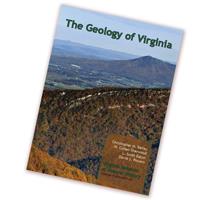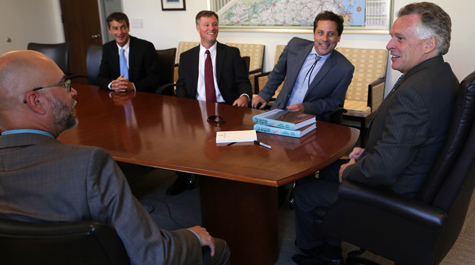Q: Why does Virginia have such good geology? A: It’s complicated
The governor had a great question for the geologists.
Why, Terry McAuliffe wanted to know, does Virginia have such good geology?
“We offered up some thoughts on that,” said Chuck Bailey. It’s the variety, he added. “Virginia has five distinct geologic regions. Very few other states have as many.”
Even though North Carolina extends further west than Virginia, the Commonwealth is favored with greater geological variety, he said.
Bailey ticked off Virginia’s geologic regions, from east to west: “The Coastal Plain, which we live on here in Williamsburg. The Piedmont — low rolling terrain with very old rocks buried by soil. The Blue Ridge, with the oldest rocks in Virginia; they’re hard, and they form resistant mountains. Some of them stick up over 5,000 feet. Further west is the Valley and Ridge, with long valleys and long ridges. And in the far southwest corner, out near Wise and Grundy, there’s a region known as the Appalachian Plateau, that’s where, for years, Virginia mined coal.”
McAuliffe asked the question in a meeting with a group that included Bailey, professor and chair of William & Mary’s Department of Geology. The occasion was to announce publication of The Geology of Virginia, a book on which Bailey was an author and the lead editor.
 Published by the Virginia Museum of Natural History, The Geology of Virginia is a long-overdue examination of the fabric of the Commonwealth. Bailey joined other editors, representatives of the Virginia Department of Mines, Minerals and Energy and officials from the museum in presenting a copy to the governor.
Published by the Virginia Museum of Natural History, The Geology of Virginia is a long-overdue examination of the fabric of the Commonwealth. Bailey joined other editors, representatives of the Virginia Department of Mines, Minerals and Energy and officials from the museum in presenting a copy to the governor.
Before Bailey’s edition, the most recent Virginia geological omnibus dates back more than a century.
“In 1907, there was a compendium of the geology of Virginia that coincided with the tercentennial of Jamestown,” he explained. Prior to the 1907 version, there was a survey of Virginia’s geology done by William & Mary graduate (and Massachusetts Institute of Technology founder) William Barton Rogers, Virginia’s first state geologist.
Other William & Mary people were involved in the book, as well. For instance Professor Emeritus Gerald Johnson is a co-author of a chapter as is Professor Brent Owens. Much of The Geology of Virginia was typeset, corrected and paginated over the past five or six years in McGlothlin-Street Hall by William & Mary geology students, Bailey said.
A new edition of The Geology of Virginia was needed because the geology of the state has changed, and the science of geology has changed to an even greater degree.
“First and foremost, there hasn’t been a full-breadth compendium since the plate tectonic revolution in the late ’60s, early ’70s,” Bailey explained. “If you go back to 1907, the understanding of larger earth forces really was missing. In the 1990s, we also recognized a massive impact crater buried at the mouth of the Chesapeake Bay.”
The new book also incorporates contemporary concerns such as landslides, groundwater contamination, coastal erosion and sea-level rise, as well as new information about mineral resources.
“And obviously since 1907, Virginia’s population has grown by many millions,” Bailey said. “We’ve gone from an almost entirely agrarian way of life to urban-suburban in many places. Some of these issues — water, soil contamination, septic fields — these weren’t such a big deal in 1907.”
















